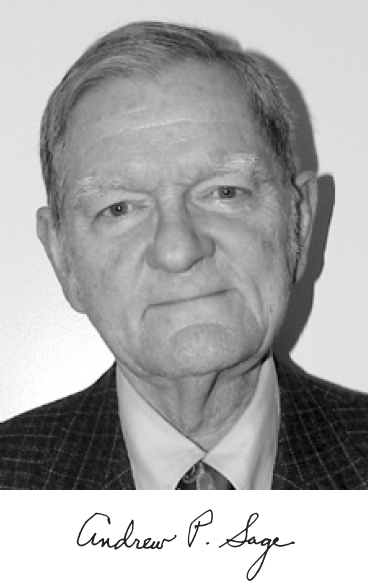1933–2014
Elected in 2004
“For contributions to the theory and practice of systems engineering and systems management.”
BY WILLIAM B. ROUSE
ANDREW PATRICK SAGE, professor and founding dean emeritus of the Volgenau School of Engineering at George Mason University, died October 31, 2014.
Born on August 27, 1933, in Charleston, South Carolina, Andrew Sage received his BS in 1955 in electrical engineering at the Citadel, the Military College of South Carolina, his MS in 1956 in electrical engineering from the Massachusetts Institute of Technology, and his PhD also in electrical engineering in 1960 from Purdue University. He received honorary doctor of engineering degrees from the University of Waterloo in 1987 and from Dalhousie University in 1997.
Dr. Sage started his academic career in the early 1960s as associate professor at the University of Arizona where, among other things, he did research on the electronic simulation of biological clocks and bistable circuits. From 1964 to 1967, he was professor of electrical engineering at the University of Florida, Gainesville. From 1967 to 1974, he was chair of the Information and Control Sciences Center at the Southern Methodist University in Dallas and chair of the Electrical Engineering Department. From 1974 to 1984 at the University of Virginia, he was professor of engineering science and systems engineering as well as associate dean of engineering. He joined George Mason University in 1984 as founding dean of
the School of Information Technology and Engineering, later renamed the Volgenau School of Engineering. In May 1996 he was elected founding dean emeritus of the school and appointed a university professor.
Dr. Sage wrote or edited over 20 books and was editor of the John Wiley Series on Systems Engineering and Management. He edited the IEEE Transactions on Systems, Man, and Cybernetics from January 1972 through December 1998, and also served a two-year period as president of the IEEE SMC Society. He played an instrumental role in establishing the INCOSE Journal of Systems Engineering in 1997 and served as the journal’s editor in chief until 2013. He was also coeditor of Information-Knowledge-Systems Management.
In addition to his NAE membership, Dr. Sage was elected a fellow of the Institute of Electrical and Electronics Engineers (IEEE) for “Contributions to engineering education, and to the theory of systems, identification, estimation, and control,” the American Association for the Advancement of Science, and the International Council on Systems Engineering.
In 1970 he received the Frederick Emmons Terman Award from the American Society for Engineering Education, and in 1994 the Donald G. Fink Prize from the IEEE and a Superior Public Service award for his service on the CNA Corporation Board of Trustees from the US Secretary of the Navy. In 2000 he received both the Simon Ramo Medal from the IEEE in recognition of his contributions to systems engineering and an IEEE Third Millennium Medal, and in 2002 an Eta Kappa Nu Eminent Member Award and the INCOSE (International Council on Systems Engineering) PioneerAward. In 2007 he was elected as a charter member of the Omega Alpha Association International Honor Society for Systems Engineering. In 2010 he was recognized by Purdue University School of Electrical and Computer Engineering as Outstanding Electrical Engineer. In 2014 he was an honoree for the Academy of Engineers at the Citadel School of Engineering.
He is survived by his wife of 52 years, Laverne G. Sage, and their children and spouses: Theresa A. Sage and husband Mike Beahan, Karen M. Sage and husband Brent Johnson, and





